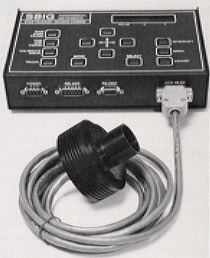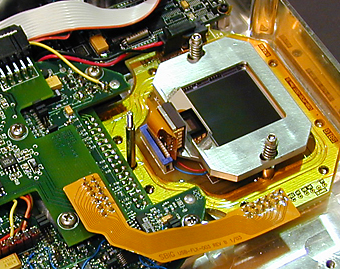 |
The
Original ST-4 Autoguider is |
THE ADVANTAGES OF CCD AUTOGUIDING
 |
The
Original ST-4 Autoguider is |
SBIG's introduction of the thermoelectrically cooled Model ST-4 CCD autoguider over 15 years ago changed astrophotography forever. Once astrophotographers determined that they could use a cooled CCD imaging camera to precisely guide their telescope in all four axes on dim guide stars, they started experimenting with the Model ST-4. Within one year we began to see astrophotographs with one to four hour exposures. Now, virtually all of the long exposure astrophotographs that have appeared in amateur astronomy journals have been guided with a CCD autoguider. Reducing the thermal noise in the CCD detector by cooling allowed very dim guide stars to be used for long uninterrupted exposures. Exactly what astrophotographers wanted!
The best autoguiding results that we have seen were achieved by the user optimizing the autoguiding software to their telescope. Our software allows you to tune the autoguider to your telescope's R.A. and Declination drive motors, hysteresis and periodic error. In this way you can match your telescope's characteristics to the autoguiding functions and achieve long uninterrupted periods of excellent guiding. Today, the STV stand alone autoguider is used by many astro-imagers as an indespensible tool for guiding long astrophotos with film and digital cameras. The self-guding ST series cameras and the self-guiding STL series cameras are well known for the many incredible long exposure CCD images taken by thousands of amateurs over the past decade.
WHY SELF-GUIDING IS ESSENTIAL - Updated
by Alan Holmes, Ph.D.
An amateur new to CCD astronomy is confronted with trying to select a camera from a large number of possible choices, with a bewildering selection of features to choose from, and at a range of prices that seem steep. Some of the features may seem to be frills, and not necessary to get good results. Self-guiding is one such feature which may not seem necessary since CCDs can image deep sky objects in just seconds. Self-guiding, though, is not a frill - it is absolutely essential to obtaining excellent images of faint objects, as this section will illustrate.
When a CCD is used to image deep sky objects, such as a nebula or galaxy, the amount of light collected by each pixel is proportional to the length of exposure, the area of an individual pixel, and the inverse square of the F/number of the optical system. For example, let us define a figure of merit as being just this:
Merit = exposure * pixel area (in microns squared) / (F# * F#)
I will also make the following statement, which I can easily prove with a variety of images.
"An old ST-6 at F/6.3 in 60 seconds can get a pretty good image of most popular objects."
Let's see what this means: an old ST-6 uses a CCD with a pixel size of 23 x 27 microns, so the figure of merit for a "pretty good image" is:
Merit = 60 * 23 * 27 / (6.3 * 6.3) = 940
 |
TC-237H
Guiding CCD located just |
Of course this approach is a simplification - a very accurate figure of merit would take into account the dark current and readout noise of the CCD camera. I will ignore these factors for this discussion.
For our ST-7, the figure of merit would be only 123 since the pixels are so much smaller. This implies you need to take an exposure about 7 times longer to get a comparable signal level as the 60 second ST-6 image. And, since the pixels are only a third as large, trailing due to guide error would be objectionable after only 20 seconds. The problem starts to become apparent - small pixels mean long exposures to get good images, along with increased sensitivity to guiding. This was the reasoning that led SBIG to put self-guiding in our popular ST-7 and ST-8 cameras (and eventually in all ST-7 series and STL series cameras): we wanted to make the longer exposures required easier. Do not be mislead by advertising - even good PEC correction will only allow you to expose for about a minute before trailing is noticed in most cases. A minute is not long enough!
Once one has decided to implement some sort of automatic guiding to enable longer exposures to be captured, one has a variety of choices. Four approaches are guiding with an autoguider using a radial off-axis guider, guiding with an autoguider using a separate guide scope, Track and Accumulate, an SBIG patented technique where multiple images are added together with shifts to produce a longer equivalent exposure, and self-guiding. Let us look at the advantages of each.
Radial off-axis guiders have a severe problem in that a small prism or mirror is used to pick off a tiny portion of the light to direct to the eyepiece. Guide stars tend to be dim, and one is forced to rotate the assembly to find a guide star. When one rotates the assembly, the star motion directions (in response to guiding inputs) also rotate, and one is forced to recalibrate the autoguider quite often. Also, the dim stars force some autoguiders to require very long exposures, negating their ability to compensate for periodic errors and drive hops. In short, radial guiders are clumsy to use.
Another alternative, a separate guide scope, works quite well for refractors and Newtonians, but poorly for SCT systems. The problem here is differential deflection - slight tilts or wobbles of the primary mirror can shift a star position significantly on the imaging CCD. The mirror tends to shift since the gravity loads change as the telescope counteracts the earth's rotation. (Don't laugh, but some SCT primary mirrors are mounted on springs)! Our experience with differential deflection is that one can only go about 5 minutes before it becomes a problem. Also, by the time one has bought an autoguider, and a separate guide scope with mounting rings, one has spent more money than an ST-7 costs relative to its cheaper competitors. And you still have to manually find guide stars.
 |
TC-237H
Guiding CCD configuration |
Track and Accumulate is a good technique at fast F ratios or with large pixels. The key to Track and Accumulate working well is to be able to use an exposure long enough that the noise due to the photon flux in the sky background dominates the readout noise. This technique is particularly effective for the older ST-6 with its large pixels, where 30 seconds at F/6.3 is long enough that the sky background dominates. It is less useful for cameras with smaller pixels.
Self-guiding is the premier approach. The full aperture of the main telescope is used, allowing maximum sensitivity. Differential deflection does not occur, since the optical system is common to imaging and guiding CCDs. Long exposures can be commanded between readouts of the imaging CCD. And, a feature not to be downplayed, one has the ability to select the guide star using the computer, with total control over the guiding process. You can see the image the guider is working with, instead of wondering whether or not the guider is in focus. With self-guiding you can take much longer exposures, and you can do it with ease. You will obtain much better images, which is why you wanted the camera in the first place! And finally, with the introduction of the AO-7 adaptive optics accessory, the built-in guiding CCD is essential for the highest resolution work produced by amateurs today.
To summarize, we make the well known STV
autoguider, and yet we chose to make it unnecessary with the ST-7/8/9/10/2000 and STL
cameras. Why did we render our own product unnecessary? We did it for several
reasons - to save our camera users money, and time, to improve the tracking, and to
simplify the tracking process to where it is no longer a burdensome chore of
astrophotography. We have since discovered that self guiding is an enabling feature,
enabling an adaptive optic system that can improve atmospheric seeing and eliminate wind
and drive fluctuations, and enabling a spectrometer that can show what's on the entrance
slit and guide itself. Astronomical applications demand the self-guiding
capability! Do not underestimate the challenge of capturing well guided hour long
images!
Alan Holmes, Ph.D.
Santa Barbara Instrument Group
Revised: September 26, 2005 10:53:58 AM.
Copyright © 1998 Santa Barbara Instrument Group, Inc. All rights reserved.
Please report any problems with this page directly to the Webmaster